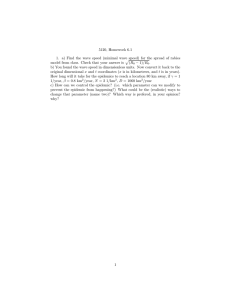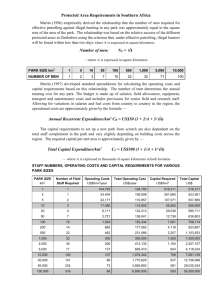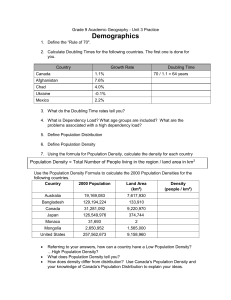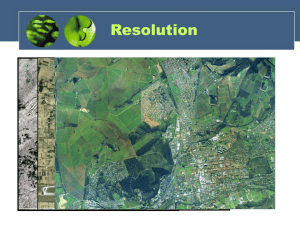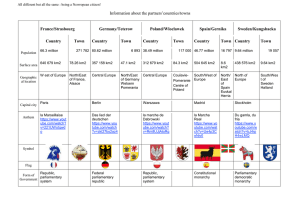BEST PRACTICES IN MANAGING GOAL AND STRATEGIES FOR Aminatuzuhariah Megat Abdullah
advertisement
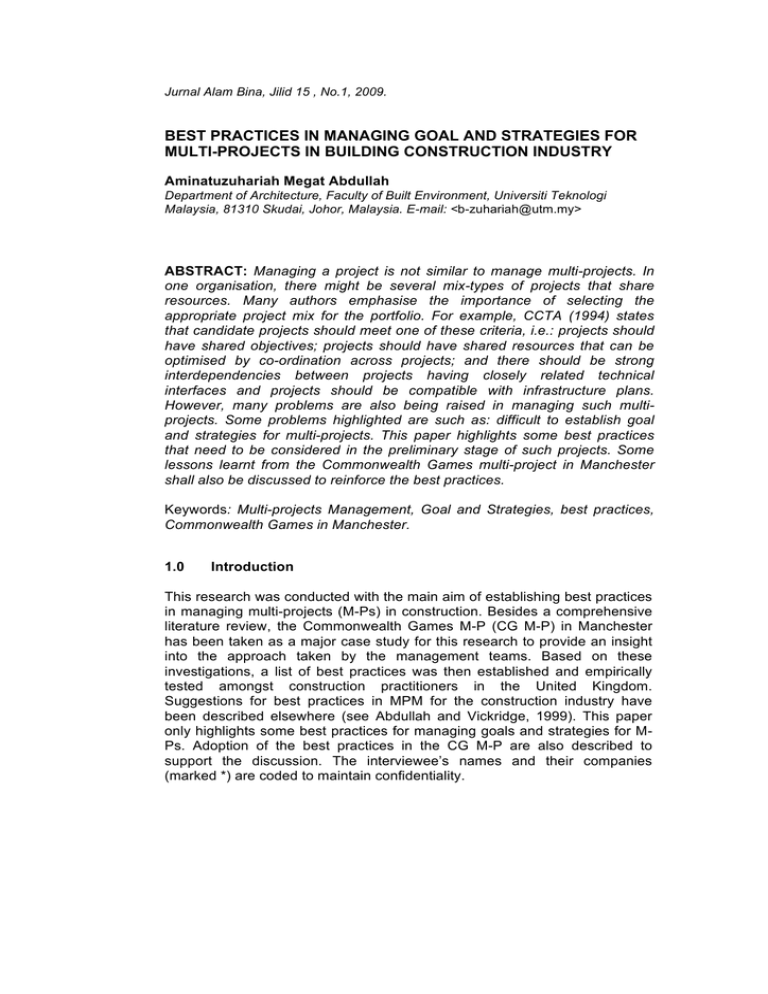
Jurnal Alam Bina, Jilid 15 , No.1, 2009. BEST PRACTICES IN MANAGING GOAL AND STRATEGIES FOR MULTI-PROJECTS IN BUILDING CONSTRUCTION INDUSTRY Aminatuzuhariah Megat Abdullah Department of Architecture, Faculty of Built Environment, Universiti Teknologi Malaysia, 81310 Skudai, Johor, Malaysia. E-mail: <b-zuhariah@utm.my> ABSTRACT: Managing a project is not similar to manage multi-projects. In one organisation, there might be several mix-types of projects that share resources. Many authors emphasise the importance of selecting the appropriate project mix for the portfolio. For example, CCTA (1994) states that candidate projects should meet one of these criteria, i.e.: projects should have shared objectives; projects should have shared resources that can be optimised by co-ordination across projects; and there should be strong interdependencies between projects having closely related technical interfaces and projects should be compatible with infrastructure plans. However, many problems are also being raised in managing such multiprojects. Some problems highlighted are such as: difficult to establish goal and strategies for multi-projects. This paper highlights some best practices that need to be considered in the preliminary stage of such projects. Some lessons learnt from the Commonwealth Games multi-project in Manchester shall also be discussed to reinforce the best practices. Keywords: Multi-projects Management, Goal and Strategies, best practices, Commonwealth Games in Manchester. 1.0 Introduction This research was conducted with the main aim of establishing best practices in managing multi-projects (M-Ps) in construction. Besides a comprehensive literature review, the Commonwealth Games M-P (CG M-P) in Manchester has been taken as a major case study for this research to provide an insight into the approach taken by the management teams. Based on these investigations, a list of best practices was then established and empirically tested amongst construction practitioners in the United Kingdom. Suggestions for best practices in MPM for the construction industry have been described elsewhere (see Abdullah and Vickridge, 1999). This paper only highlights some best practices for managing goals and strategies for MPs. Adoption of the best practices in the CG M-P are also described to support the discussion. The interviewee’s names and their companies (marked *) are coded to maintain confidentiality. BEST PRACTICES IN MANAGING GOAL AND STRATEGIES FOR MULTIPROJECTS IN BUILDING CONSTRUCTION INDUSTRY 2.0 The Difference between Project Management and Multi Project Management (Mpm) Based on the author’s research on MPM for construction industry in the UK, there are vast differences between project management and MPM. According to Turner (1992), traditional project management has concentrated on scoping, planning, management and control of a single project. It aims to deliver well-defined tangibles or deliverables within specified parameters of cost, time and quality. However, in the M-P environment, while each project will retain its own scope and goals, all teams should be tuned into the overall “M-P goal”. This M-P goal is what the M-P manager, and the M-P teams strive to achieve, being given a specific time and set of anticipated benefits. Many authors (such as Olford, 1994; CCTA, 1994; Shi and Chen, 2005) agree that managing M-Ps is different to managing a single project. Based on the literature review, the differences are summarised in the Table 1.0. Table 1.0: Differences between a single project and M-P Project Management (PM) Multi-project Management (MPM) Has a dedicated project team headed by a project manager with the responsibility and authority to get it done. Has less stakeholders, thus there shall be less conflict in terms of views and it is easier to achieve conclusion in decision making. Deals only with one type of project. Often sharing resources: with team members working on many projects over a short time. Less resource needed in terms of materials, finance and human resources. Thus it is easier to plan and control the project. Has definite start and end dates. Has a clear objective Has a well-defined scope. Has an intense and focused activity that is ‘driven’ by the projects that are to be delivered. Has definite change control mechanisms but is best suited to objectives that are closely bounded and relatively certain. Project Management is suited to deliver a project or product. 2 Has many stakeholders and each has different objectives. Thus, it is difficult to agree on certain decisions. Have various types of project which have different sets of objectives and criteria. Large number of resources needed, thus its levels of complexity, conflict of interests and risks are much higher than managing single projects. The management style and structure are also more complex. Projects continuously being added to the mix of projects and the end date of the current workload is extended Has unclear objectives and may not be consistent across all projects. MPM means the constant addition of new projects possibly resulting in major changes in scope and priorities. MPM is a broadly spread activity that uses a process approach and is concerned with more broadly defined objectives. MPM is suited to orchestrating large numbers of component projects and activities with complex and changing interrelationships, in an uncertain environment (that is, a larger and more dynamic environment). MPM is suited to managing the impact of and the benefits from a number of component projects and ensuring that there is a smooth transition into a new business operation. Aminatuzuhariah Megat Abdullah PM is a discipline to direct and manage a project, which focuses on a tactical issue MPM is the integration, prioritisation, communication and continuous control of multiple projects, which focus more on a strategic issue and to achieve broad M-P objectives. 2.1 Problems in managing M-Ps The emergence of a new alternative approach to managing M-Ps is due to many problems associated in managing them. The problems highlighted by various authors are as follows: i. Less attention from senior management due to the fact that the systems used only provide visibility of individual projects (Olford, 1994; Shi and Chen, 2005); ii. Difficulty in establishing M-P goals and objectives due to the involvement of many stakeholders in the M-P environment (Eskerod, 1996; Shi and Chen, 2005) and inconsistency of the objectives across all projects (Olford, 1994); iii. Changes in project scope and priorities due to constant addition of new projects (Knutson, 1994). For example, according to Olford, the addition of a large project into the human resource workload may cause major disruption, necessitate re-planning and affect one’s focus; iv. Complexity in managing M-Ps due to the differences in size, skill mix, and urgency of M-Ps (Payne, 1995). Due to the dynamic nature of M-Ps, it may be very difficult to get an overview of the project pool, to keep an eye on each project, (Eskerod, 1996) and to prioritise between the projects (Knutson, 1994); v. Difficulty in allocating and assigning resources due to the complexity of the projects (Eskerod, 1996). Unanticipated resource conflicts cause delays and cost more to meet completion dates (Olford, 1994); vi. More risk in managing a M-P due to the extended period of time for a M-P and the initial lack of a detailed M-P specification (CCTA,1996; Eskerod, 1996). Without a clear process of priority setting and resource allocation, the general management responsible for the M-P will risk getting lost in the details of individual project plans and manpower allocations (Olford, 1994; Amos and Aithen, 2004); vii. Communication and co-ordination problems due to the diversity of the team members, their various locations and the types of projects (Gibson & Marlow, 1998; Hu et.al., 2009). 3 BEST PRACTICES IN MANAGING GOAL AND STRATEGIES FOR MULTIPROJECTS IN BUILDING CONSTRUCTION INDUSTRY 3.0 3.1 Best Practices for Managing Goals and Strategies for M-Ps Practice 1: “Assemble Team Committed to Developing M-P goals and Strategies, Taking Account of the External Environment and Customers/stakeholders Objectives, Needs and Requirements”. In response to the problems (i) and (ii) stated in item 2.1, many authors share a similar opinion based on their experiences in managing M-Ps. Lack of senior management attention is always a problem in MPM. To mitigate this problem, many authors (for example, CCTA, 1994; Pells, 1998 and Hu et. al., 2009) emphasise the need to ensure top management support early in the M-P definition stage. Senior management also need to recognise the full scope of the work and resources for individual projects (Knutson, 1994; CCTA, 1994 &1996) ensure that mechanisms exist to match the demand for project resource with available capacity and viceversa (Hastings, 1996; Hans, et.al., 2007). To ensure the success of M-P delivery, MPM teams must be assembled and various skills need to be identified, relevant to the challenges that the M-P will face. To improve M-P performance, it is better to utilise the best available skills and experience both within and outside the organisation (CCTA, 1994; Hastings, 1996; Lanying et.al., 2007). CCTA (1994) recommends early appointment of a M-P director and a M-P manager during the definition stage of the M-P, to give advice on how to establish the management structure for the MPM. Due to the complex role and his/her involvement at all levels of the organisation or multi-organisations, many authors (such as Laufer, et.al., 1996 and Gibson & Marlow, 1998) stress the importance of the M-P manager having excellent leadership qualities. Good leadership leads to the establishment of a cultural environment for the M-P which is one of “Truth, Trust and Teamwork” (Aritua et.al., 2009). 3.1.1 MPM Structure for CG M-P in Manchester Manchester City Council (MCC) as a main client for the CG M-P in Manchester has set up various organisations to help in managing the demand of the CG M-P. The major units are Manchester 2002 Limited, the Sport Development Group and a well known Project Management Consultant (CL1)*. MCC also works hand in hand with a developer (CON2)*, and other consultants to develop the Eastland Sport-city. Specialist skill requirements and suitable consultants for developing the CG M-P brief, goals and strategies as well as the master plan were identified and appointed early to help the MPM team to ensure successful delivery of the M-Ps. The overall organization of the M-P is described below. 4 Aminatuzuhariah Megat Abdullah 3.1.2 Manchester 2002 CG Delivery Structure MCC has to liase with English Sport Council (ESC) to ensure that the M-P complies with its requirements. Besides that, the Commonwealth Council for England’s (CCE) requirements also have to be taken into consideration. The major role of the CCE is to outline technical requirements for the facilities to be built to suit the CG requirements. For example, “National Stadium Framework Document”, established by the CCE and ESC, sets out the objectives and requirements for the Stadium which must be met. It also spells out the information they require, to enable them to evaluate and select a preferred bidder that would be eligible to receive a Lottery Sports Fund award. The overall organisation of the M-P is shown in Figure 1. Strategic Level COMMONWEALTH COUNCIL FOR ENGLAND MANCHESTER 20002 LIMITED - CG delivery MANCHESTER CITY COUNCIL – MAIN CLIENT CL1 CG M-P Delivery PRIVATE SECTOR FUNDERS M-P Level Project Manager 1 Project Team ENGLISH SPORTS COUNCIL - M-P's SPONSOR SPORTS DEVELOPMENT GROUP - Sports Development Programme CON2- DEVELOPER PM5 - Master Planner SPECIALIST CONSULTANTS Project Manager 2 Project Manager N Project Team PM4 - Cost Consultant and M-P Advisor Project Team Project Level (Same for every project) Figure 1: Manchester 2002 Delivery Structure Manchester 2002 Limited - This organisation was set up and is underwritten by Manchester City Council. In general, it is responsible to satisfy regeneration strategies as stated in item 3.3.1 and to ensure efficient delivery of the Games. Its tasks include: • To develop the programme for the CG event; • To liaise with the private sector and obtain finance to sponsor the Games; 5 BEST PRACTICES IN MANAGING GOAL AND STRATEGIES FOR MULTIPROJECTS IN BUILDING CONSTRUCTION INDUSTRY • To ensure good political relationships with the commonwealth countries during the Games; • To advertise and arrange media coverage of the Games; • To ensure the security of the Games; and • To ensure efficient transportation of participants, etc. other Sport Development Group – MCC has also established a Sport Development Group to help them study the benefits of all the sports facilities for the community before and after the Games. It is also responsible for drawing up Sports Specific Development Plans and the requirements for all the facilities (MCC, 1995). This is done to achieve the main objective of MCC to make the CG facilities sustainable and accessible to the wider communities in the North West region after the Games. The development of the scheme was also made possible by working in partnership with private developers (such as CON2)*. There was constant liaison with various governing bodies (for example CG for England and ESC), and the Greater Manchester authorities in order to ensure total success in the CG M-P delivery. 3.2 Practice 2: Initiate M-Ps that Reflect and Achieve Business Goals and Strategies Best practices 2 have been developed in responds to the problem (iii) stated in item 2.1. According to CCTA, 1994 and Fu et.al. 2006), the need for M-Ps is usually triggered by a specific requirement to bring about change, for example to implement new government policy, or to achieve other business goals and strategies. In one organisation, there might be several mix-types of projects that share resources. Many authors (such as CCTA, 1994; Sommer, 1998; Lauying et.al., 2007) emphasise the importance of selecting the appropriate project mix for the portfolio. For example, CCTA (1994) states that candidate projects should meet one of these criteria, i.e.: • Projects should have shared objectives; • Projects should have shared resources that can be optimised by coordination across projects; • There should be strong interdependencies between projects having closely related technical interfaces; • Projects should be compatible with infrastructure plans. The author’s investigation on the C-G M-Ps reveals that the Manchester City Council as a client for C-G M-Ps, has iniatiated many other M-Ps such as 6 Aminatuzuhariah Megat Abdullah Millennium Projects, Great Northern Initiatives, Conference Centre and Multiplex Cinema. The M-Ps shared the same objectives i.e. to satisfy regeneration strategies for the Greater Manchester. 3.2.1 The CG M-P and link to Regeneration Strategies. As a representative for the local government, MCC is committed to ensuring that the CG facilities comply with the Regeneration Strategies. These strategies were established in 1994 through partnerships with various private bodies. The core regeneration strategies for Manchester are as follows: (Abdullah, 2000) • To increase the population of the City; • To attract or develop more multi-national companies; • To increase employment for local populations; • To provide full access to all sections of the community to the services and facilities that the City offers; • To reclaim and develop derelict land and buildings to European regional capitals standards; and • To provide a quality environment and sustainable development within the city, for the long term benefits of residents, and enable local people and future generations to enjoy an enhanced quality of life economically, environmentally and socially. Besides being a 'vehicle' for the regeneration of the Greater Manchester area, the CG M-P acts as a vehicle for getting investment from the Sports Lottery Fund to boost the image of Manchester and to increase economic investment opportunity in Manchester. 3.3 Practice 3: “Identify the Potential Benefits of Each M-P” Similar to the management of a single project, in MPM, the importance of the M-P brief and business case is also emphasised by CCTA (1994 & 1996) and Lauying et.al., (2007). The M-P business case (also called the M-P baseline by some authors) should be established with the objective of measuring costs and benefits resulting from investment into the M-P (CCTA, 1994). These are very closely associated with the strategic objectives and the production of end deliverables. According to Strange (1995) and CCTA (1996), the M-P business case may well form part of the contractual issues but are most certainly clearly defined in the scoping document or terms of reference for the M-P. The M-P business case provides the boundaries in which the M-P may operate and carefully defines the scope of the M-P in order to facilitate change control (CCTA, 1994; Hanh and Ruppel, 2008). 7 BEST PRACTICES IN MANAGING GOAL AND STRATEGIES FOR MULTIPROJECTS IN BUILDING CONSTRUCTION INDUSTRY The objectives of M-Ps are not only to complete projects on time, within budget, and meeting technical objectives (as in traditional Project Management), but that projects deliver business results as well. Benefits can either be tangible or non-tangible. For example, Chapman, (1998) who, writing as a consultant, states that “it is important not to use financial value as the only measure for making decisions on the business value for a M-P”. Giving one example, she states that getting a product to market quickly can make or break the company, but this is not usually a benefit that can have specific financial value assigned to it. This can be valued in terms of alignment with business objectives and the need to manage business risk (Amos and Aithen, 2008). The benefits of the CG M-P were well investigated, for example, MCC defined the objectives that the final delivery of the CG facilities should: (Abdullah, 2000) • Be completed on time, • Meet targeted cost, • Achieve good quality, • Satisfy regeneration strategies, • Satisfy all stakeholders requirements, and • Provide value for money. 3.4. Practice 4: “Value Management Workshops Involving All Stakeholders Should Be Held in the Early Stage of the M-P to Assist Client to Develop M-P Goals and Strategies" One unique characteristic of the CG M-P is the existence of several different stakeholders in the M-P. Each of them has different objectives and requirements. The VM approach has addressed this important issue and has recommended various VM workshops attended by all the stakeholders to prioritise the objectives and requirements of the project/s. This approach has been adopted by MCC, where its design teams and all of the stakeholders met frequently, to study various guidelines established by Commonwealth Games for England, English Sports Council and the Manchester City Council business strategies. The operational sustainability of the M-P is considered to be the main priority, together with meeting the cost, quality and stakeholders’ satisfaction. Many negotiations have been made to ensure that the design satisfies all the stakeholders' requirements. Viability and feasibility of the projects, such as their initial capital costs, future operational and maintenance costs, and project revenues, were all studied thoroughly with the help of various specialists (Abdullah, 2000). 8 Aminatuzuhariah Megat Abdullah 3.5. Practice 5: “Establish policies and standards to be followed, establish and document M-P business case for future interpretation and reference". Based on their experience, Jones & Weiskittel, (1997); Lauying et.al., (2007) emphasise the need to establish policies, procedures and standards to define the “rules of the road” for all projects. The necessity for these documents in managing M-Ps has been agreed upon by many authors, such as Olford (1994); Yager (1997); Palmer (1997). Olford (1994) also stresses the importance of imposing discipline to ensure the procedures and standards stick, and that procedures should be brief and require only a minimum of paperwork and approvals (Palmer, 1997; Aritua, et.al., 2009). Based on many years experience in delivering regeneration projects (for example: Nynex Centre, Bridgewater Complex, and Art Galleries), many policies and standards had been established by MCC to be followed by both internal and external MPM teams. These policies/standards include: value management policy, safety in design and construction (according to CDM Regulations, 1994), Health and Welfare Policy (according to recent Construction (Health, Safety and Welfare) Regulations, 1996), environmental policy, quality procedures, equal opportunity policy, and “Towards 2000 Together” (a policy to train local labourers to ensure that there is a ready pool of local, skilled labour and that training is tailored to meet the construction sector’s growing need in Manchester). The team has also developed design strategy that relates to the statement of policies and standards applicable to the M-P and project activities and deliverables. Examples of these are the need for the MPM team to: (Abdullah, 2000) • Design the M-P to reflect the M-P goals and strategies, sort out all legal and statutory requirements, and establish information and data before embarking on the design. • Establish design guidelines outlining, for example, the design parameters for projects within the M-P, the materials palette identifying the materials to be used by the design teams, and the design and development frameworks to highlight design issues to be addressed by developers and their design teams. This is needed to ensure developers and their architects proceed to final design as quickly and securely as possible and to preserve the overall coherence of design of both the M-P and the infrastructure services. • Establish budget and schedule, and clarify objectives of individual projects within the same site to ensure the M-P achieves quality standards and conformity to the broad master plan objectives. 9 BEST PRACTICES IN MANAGING GOAL AND STRATEGIES FOR MULTIPROJECTS IN BUILDING CONSTRUCTION INDUSTRY • • Adopt Value Management techniques for the whole process of design management to ensure best value for money for both the M-P and the individual projects. Set out milestones for each stage of the M-P and the individual projects, incorporating, for example, when consents and permits of the individual projects, and funding approval need to be obtained. During the execution stage of the M-P, the M-P manager and the lead designers must also ensure that each individual project within the M-P achieves the M-P goals and objectives which include the M-P benefits identified earlier in the M-P goals and strategies element. The ultimate requirement of the ESC is the establishment of the business case for the MP. The contents of the business case must satisfy all the ESC and other stakeholders’ requirements. 3.6 Practice 6: "Identify funding sources and requirements". The author’s investigation of the CG M-P reveals that key issues considered in the PM literature were also relevant to MPM. Examples of issues considered are: definition of M-P sponsor’s objectives, M-P appraisal, establishing the preferred method of financing, developing the appropriate financial structure, discussion with potential sources, negotiating and finalising financing agreements and managing finance. A wide variety of funding has been acquired for the CG M-P. Three distinct finance resources are: 1. The English Sports Council Lottery Fund who provide two thirds of the funding of all the facilities (the total amount is £150 million). 2. The Local Authority contributes about £25 million. 3. Major capital comes from associated commercial development (which consists of a number of private companies). The amount of £30 million has been invested in urban programmes in order to clear the Eastlands site and to relocate businesses. Other sources of funds are from English Partnership (funding inner city site), Derelict Land Grant, and Urban Development Grant. Since most of the projects rely on public funding, the sources of finance for each project have to be identified, and links with potential sponsors established in order to understand the sponsors' requirements for eligibility for funding. Financial implications of the M-P in capital and revenue terms are also appraised from time to time for all projects within the M-P's portfolio. The government and MCC’s partners have demonstrated their complete support for the scheme through commitments made to providing matching funding towards the total capital costs and revenue funding contributions 10 Aminatuzuhariah Megat Abdullah towards the operating deficit. The grant funding will complete the funding plan which will ensure that high profile state-of-art facilities can be delivered. 3.7 Practice 7: "Identify implementation time scales and resources for each M-P." M-P Planning and Resources Management is at the heart of the MPM process. It starts with the identification of the portfolio of projects in the M-P, and continues with a description of the M-P scope of work, the milestones, the schedule and the overall budget. It has been well recognised that in a MP environment, resources are being shared across this portfolio of projects, and hence, balancing resources within a single organisation is of prime importance in the MPM approach (Scheinberg and Stretton, 1994; Hanh and Ruppel, 2008). Since a M-P consists of many projects of different sizes, types, complexities, and in some cases is dynamic (i.e. having constant additions of new projects as described in section 2.4), projects have to be prioritised to establish their sequence of implementation (for example CCTA, 1994; Ireland, 1997), and to prioritise resources utilisation (Yager, 1997; Hanh and Ruppel, 2008) the "Sports Facilities Development Plan", immediately after Manchester won the CG bid in November, 1995. Projects had been prioritised, and the sequence of projects, together with their interdependencies, were worked out and presented in the same report. For example, the feasibility studies and the design of the Swimming Pool and the Sportcity facilities, especially the Stadium, had been prioritised as very important and to be carried out early due to their high level of complexity. Hence, the work on these facilities has been underway since mid 1996. The need for a planner was recognised as essential in early 1998, when DG* and DH* were appointed to oversee the programme and progress for the Sportcity. According to CLA*, the objectives of appointing the planners were to establish realistic targets for achieving the pre-construction programme for the Stadium. They produced an integrated suite of programmes, charts, drawings and method statements, which logically analyse the project sequencing and timing and provide the team with the opportunity to fully understand the strategy of the Sportcity development. DG* and DH* highlighted how the process of planning the M-P is about teamwork and must not be seen as under the sole jurisdiction of a single individual. In this M-P, all MPM team members (for example, the client, designer and contractor) provided information on time-scales, costs and resourcing needs for each project, and agreed to the plan for each stage of 11 BEST PRACTICES IN MANAGING GOAL AND STRATEGIES FOR MULTIPROJECTS IN BUILDING CONSTRUCTION INDUSTRY the project. Milestones for drawdown of grants were also included as part of the schedule of costings. 3.8 Practice 8: “Identify each M-P risk and obtain early expert advice to analyse and manage risk” Similar to the management of a single project, the process of managing risks has been recognised as: identification, assessment, planning, and mitigation of risks (Pells, 1998; Howard, 1998; Gerosa et.al., 1999). Identified risks are formally documented in a risk register and assessed for severity in terms of the negative consequences and the likelihood (Howard, 1998), and presented to the M-P manager or team leader to be assessed and analysed (Aritua, et.al., 2009). In analysing the risks at M-P level, Laufer et.al. (1996); Hu et.al., (2009) emphasise that the decisions made by the M-P manager must be at the right time with the appropriate horizon and degree of detail. Hence, participation from all MPM team members is vital in order to provide this detail throughout the MPM process (Odum et.al., 1998). According to Laufer et.al. (1996), while under conditions of certainty, high interdependence of processes or tasks might be a sign of the optimal utilisation of resources, under conditions of uncertainty a few uncertain tasks can quickly proliferate into uncertainties of all components of the plan. The M-P manager should then decouple interdependent tasks and isolate them from those plagued by high uncertainty (Laufer, et.al., 1996). Laufer et al. (1996), also recommend that a successful M-P manager gives inward and outward attention to project risks to avoid unexpected contingencies. According to them, as an integrator of disparate parties, each with a different orientation and focus, the M-P manager must be able to translate and bridge the gap between the customer, the designers, and the constructors. Table 2.0: Sources of risks in the CG M-P and their mitigation measures (Adapted from Abdullah, 2000) 12 Aminatuzuhariah Megat Abdullah Sources of Risks External Factors - Inflation - Planning/development risk - Transportation Mitigation of risks • • • Design Risks - Procurement of resources for design - Quality in design - Design scope and quality management • • • Construction Risks - Site remediation – enabling works - Site history • • • CG – Construction Phase One - Approvals, planning permission and licensing - Poor construction performance - Changes in design and construction • • • Permanent Stadium – Construction Phase Two: Approvals and licensing Interfaces with other parts of the project • • An inflation allowance of 4% had been made during design and construction. Detailed planning application made prior to commitment of expenditure, other than on ground reclamation. Sufficient transportation provided by pedestrian access, bus/coach or car without reliance on light or heavy rail. The procurement of the design resources used a flexible and staged approach incorporating cost reimbursable and design competition. This has mitigated of selecting an inappropriate route too early. Independent design assessments had been carried out to ensure the design is of the highest standard. With technical assistance from the design team MCC undertook responsibility for ensuring that the design meets the requirements of each of the primary project stakeholders and following quality guidelines. Site investigation works had been carried out and the results were taken into consideration during the design process. Undertake services diversions in advance of the main construction works to reduce the risk of delay to the main works. The procurement strategy adopted is to separate the remediation and services diversion works for the construction works in a stand-alone enabling works contract. This method reduces the risk of planning delays and of unnecessary costs being incurred. All known interested parties had been consulted and the following had been developed to reduce risk: legal agreements with MCFC, separate planning applications for enabling works and construction, purchase of the north site, a case for exemption from the need for a Waste Management Licence and investigation of MCC Building Control’s opinions on licensing requirements. The appointment of a main contractor who was competitively selected through a first stage tender. This single point of responsibility is maintained by novating the design team to this contractor after a stage two award. The procurement strategy should ensure that the standard set in the design stage is maintained through the construction phases and this would be reinforced by close working relationships between the design team and contractors. Minimise changes by the M-P stakeholders by exhaustive use of the consultation process. Extensive consultation process in addition to development of legal and licensing agreement. Separate masterplanning consultant (PM5) to liase with commercial developers. 13 BEST PRACTICES IN MANAGING GOAL AND STRATEGIES FOR MULTIPROJECTS IN BUILDING CONSTRUCTION INDUSTRY The risks of the CG M-P were identified and analysed during the Stadium’s design stage. In respect of the Sportscity Development, design and construction risks were assessed by the design consultant (DE1)*. The risks considered and their mitigation measures are summarised in Table 2.0. 3.9 Practice 9: "Identify requirements for support services, and initiate communication plan." CCTA (1994) recommends that support services, such as accountancy, staffing, finance and personnel, need to be identified and established to ensure the efficiency of the MPM. To reduce the complexity in managing MPs, many authors (such as Olford, 1994; Payne, 1995; Baccarani, 1996; and Laufer, et.al., 1996) suggest the use of “integrated management” as a support service for the MPM team. Laufer, et.al. (1996) define the term “integrated” as “the preparation of all functional plans (for example scope definition, design basis, budget, schedule, human resources, logistics and support, contracting and procurement as well as construction) simultaneously and interdependently”. According to Amos and Aithen, (2004), in order to prepare these functions, involvement and integration of all concerned parties is needed as early as possible in the planning stage of a M-P. To ensure smooth distribution of information, Fleming & Koppelman, (1996) suggest that commitment from all parties is needed to gather and determine what information needs to be distributed. But Tørsleff, (1998) believes that how the information will be collected, reported, and distributed, who will receive the reports, and how those reports will be used to achieve the M-P’s goals and objectives are also important. All these functional plans contribute to the decisions made along the M-P life cycle (Laufer, et.al., 1996; Shi and Chen, 2005). Based on the author’s investigation on the CG M-P, the client and the other consultants have established M-P support office and have selected appropriate project management and supporting software for use by all organisations involved in the M-P planning and control. Most of the design and specialist work, such as architectural design, civil and structural design, mechanical and services for the Stadium and United Kingdom Sports Institution (UKSI) main buildings, are provided by DE1* and its daughter organisations. For example, the master planner (PM5)* and the design consultants (DE1)*, have their own in-house CAD Management unit which is responsible for the production and control of CAD drawings, ranging from the master plan to detailed drawings. This department is also responsible for the coding, storage and distribution of drawings issued by the master planning team, and design teams. It is also responsible for managing the distribution of electronic copies of the master plan and design information. With the 14 Aminatuzuhariah Megat Abdullah establishment of the M-P support office, information related to the design of the facilities is well taken care of. In response to the communication and co-ordination problems, many authors (such as Olford, 1994; Laufer et.al., 1996; CCTA, 1996 and Gray, 1997) believe that clear communication, a view of the big picture and teamwork are essential ingredients for M-P success. According to Ireland (1997), organisations using a MPM approach must consider new methods of collecting information and reporting that information to the proper individuals. MCC and the MPM teams are fully aware of the importance of communication in the Sportcity development. Since the distance between the companies are far away, the use of new technology such as the internet and web technology, as well as e-mail are used to provide new alternatives for communication, which are easier to use and access. Products supporting videoconferencing, data sharing, co-working on applications, team whiteboards, and other functions are readily available and within the reach of a project team. With this modern technology, MPM teams can send copies of documents, spreadsheets, presentations, and other project information to just about anyone with a computer and a modem. 3.10 Practice 10: “Maintain each project within the M-P to ensure that they achieve the M-P goals and strategies”. To alleviate the problems mentioned in section 2.1 further, many authors (such as Scheinberg & Stretton, 1994; Olford, 1994 and Hans et.al., 2007) recommend that M-P managers to should simultaneously maintain each project within the M-P and monitor the utilisation of the resources and the achievement of objectives (due to changes in the project’s environment) by scanning the environment and monitoring the changes in the critical assumptions to allow timely revisions of the plan and occasionally also of objectives. To do this, the M-P manager needs project managers to report project status and variances regularly (Olford, 1994). Progress must be measured, and adjustments should then be made to the M-P Implementation Plan to reflect the status of the project portfolio. Based on the author’s discussion with one of the CG MPM team (who is the overall capital cost manager for the M-P), he stresses the importance of the project manager of each project predicting future events regularly to identify potential variances. According to him, this can be achieved by identifying trends or by tracking the logic sequence to predict future delays and resultant disruption. 15 BEST PRACTICES IN MANAGING GOAL AND STRATEGIES FOR MULTIPROJECTS IN BUILDING CONSTRUCTION INDUSTRY 4.0. Conclusion This paper has discussed the best practices for managing goals and strategies for M-P for the construction industry. The adoption of the practices in the C-G M-P reinforced the importance of the practices and led to the success delivery of the CG M-P at Eastland Sport city in Manchester. The business goals that link to regeneration strategies that was set for Eastland provides a high quality unique environment and a lively setting, appropriate for the celebration of international sporting events. The master plan for the main venue of the games has been developed in considerable detail, covering various issues such as the impact of the development on the regeneration of the whole site, and the potential for it to underpin regeneration efforts across East Manchester. The regeneration of Eastland site is considered to be a major opportunity that unlocks under-utilised resources, physical, economic and social. It is hoped that, unlike some facilities built for previous international games, the Sport city development, particularly the main Stadium will not become “white elephants” and a burden to the taxpayers. Besides meeting the regeneration programmes and providing long term sustainability of the usage, it is hoped that Sport city will offer visitors from throughout Europe, a worldclass, year round, sports tourism destination. References Abdullah, A.M., & Vickridge, I.G., (1999), “Best Practice for MPM in the Construction Industry”, Proceedings of the COBRA 1999, RICS Construction and Building Research Conference, Vol.2, pp.169-179, The RICS London and University of Salford, Salford. Abdullah, A.M., (2000), ““Best Practices for Multi Project Management in the Construction Industry”,PhD thesis, UMIST Manchester. Amos, Q.C., Aitken, O.C., (2004), “Project Management for All Seasons – Financial Risk Mitigation in a Challenging World”, Proceedings for PACRIM 2004 Congress, Sept. 19-22, Adelaide, Australia. Aritua, B., Smith, N.J., Bower, D., (2009), “Construction Client MultiProjects – A Complex Adaptive Systems Perspective”, International Journal of Project Management, Vol. 27, Issue 1, pages 72-79. Baccarini, D., (1996), “The Concept of Project Complexity- a Review,” International Journal of Project Management, Vol. 14, no. 4, pp. 201-204. 16 Aminatuzuhariah Megat Abdullah CCTA, (1994), “A Guide to Programme Management”, Programme and Project Management Library, Central Computer and Telecommunications Agency, The Stationary Office, London. CCTA, (1996), “Programme Management”, Programme and Project Management Library, Central Computer and Telecommunications Agency, The Stationary Office, London. Chapman, M.R., (1998), “Benefits Management – Going Beyond Program Management”, Proceedings of the 29th Annual Project Management Institute 1998 Seminars & Symposium, Long Beach, California, USA. Eskerod, P., (1996), “Meaning and action in a multi-project environment”, International Journal of Project Management, Vol. 14, No. 2, pp. 61-65. Fleming QW and Koppelman J M. (1996), “Integrated project development teams: another fad.....or a permanent change”, International Journal of Project Management, Vol. 14. No. 3, pp. 163-168. Fu, D.C., Lin, Z.Y., Yang, L.Y., (2006), “Enterprise Program Management System in Construction Industry”, Proceedings for the 20th IPMA World Congress on Project Management, Vols. 1 & 2, pages 678-684. Gerosa, S., Cencetti. M., Sarno. M., (1999), “Methods and Applications of Risk management in Space Programs”, Proceedings of the 30th Annual Project Management Institute 1999 Seminars & Symposium Philadelphia, Pennsylvania, USA. Gibson, L.R., & Marlow, S.P., (1998), “A Practical Approach to Portfolio Management in the Pharmaceuticals Industry”, Proceedings of the 14th World Congress on Project Management, June 10-13, Slovenia. Vol. 1, pp. 154160. Gray, R. J., (1997), “Alternative Approach to Programme Management,” International Journal of Project Management, Vol. 15, No. 1, pp. 5-9. Hanh, L.Q. and Ruppel, U., (2008), “Robust Process-Based Multi-Project Scheduling for Construction Projects in Vietnam”, Proceedings for the 7th European Conference on Product and Process Modelling, Sept. 10-12, Sophia Antipolis, France.., Leus, R., (2007), “A Hierarchical Approach to Multi-Project Planning Under Uncertainty”, Omega International Journal of Management Science, Vol. 35, issue 5, pages 563-577. Hastings, C., (1996), “Development Process for Improving Project Performance in Multi-Project Based Organisations”, Proceedings of the 17 BEST PRACTICES IN MANAGING GOAL AND STRATEGIES FOR MULTIPROJECTS IN BUILDING CONSTRUCTION INDUSTRY “IPMA 96” World Congress on Project Management, Paris, France, pp. 171 – 178. Howard, P. A., (1998), “Megaproject Management Using Program Management Techniques”, Proceedings of the 29th Annual Project Management Institute 1998 Seminars & Symposium, Long Beach, California, USA. Hu, F., Gu, W.J., Li, L., (2009), “Research on Conflict Measurement Model of Project Managers under the Enterprises’ Multi-Project”, Proceedings for the 8th Wuhan International Conference on E-Business, Vols I-III, pages 18501855. Ireland, L.R., (1997), “Managing Multiple Projects in the Twenty-First Century”, Proceedings of the Project management Institute 28th Annual Seminars & Symposium, Chicago, Illinois, pp. 471 – 477. Jones, K., & Weiskittel, J., (1997), “Program Management: A Key for Integrated Healthcare Delivery Systems”, Proceedings of the Project Management Institute 28th Annual Seminars & Symposium, Chicago, Illinois, pp. 975- 980. Knutson, J., (1994), “Managing Multiple Projects in a Matrixed Organisation”, Proceedings of the Project Management Institute, 25th Annual Seminar, /Symposium, Vancouver, Canada. Laufer, A., Denker, G.R., & Shanhar, A.J., (1996), “Simultaneous Management: the key to excellence in capital projects”, International Journal of Project Management, Vol. 14. No. 4. pp. 189-199. Lauying, D., Yongdong, S., Chunfang, Y., (2007), “Strategy Implementation by Project Portfolio Management in Construction Enterprise: Success Factors Reflected from Empirical Study”, Proceedings of 2007 International Conference on Construction and Real Estate Management, Vols. 1 & 2, pages 31-35. Ledet, W. J. and Maroulis, S. J., (1998), “Improving Project Performance with Simulation and Practice”, Proceedings of the 29th Annual Project Management Institute 1998 Seminars & Symposium, Long Beach, California, USA. Manchester City Council, (1994), “City Pride – A Focus for the Future”, Manchester City Council, Manchester. 18 Aminatuzuhariah Megat Abdullah Manchester City Council, (1996), “Manchester Sport Facilities Development Plan”, Manchester City Council, Manchester. Manchester City Council, (1999), "Sports lottery Application for Eastlands Sportcity, Manchester City Council, Manchester. Odum, R. F., Carrier, L., Babich, N., Hunt, B., LePoint, R. and Shedd, J., (1998), “Program Management Process on F/A – 18E/F – New Directions”, Proceedings of the 29th Annual Project Management Institute 1998 Seminars & Symposium, Long Beach, California, USA. Olford, W.J., (1994), “Why is Multiple-Project Management Hard and How can we make it Easier?" Proceedings of the Project Management Institute 25th Annual Seminar/Symposium, Canada. Palmer, R.,(1997), “Practical programme management”, Project Manager Today, (January), pp. 16-17. Payne, J. H., (1995), “Management of Multiple Simultaneous Projects and State-of –Art Review”, International Journal of Project Management, Vol. 13, No. 3, pp. 163-168. Pells, D. L., (1998), “Program Managers, Plans: Effective Tools For Managing Multiple Projects”, Proceedings of the 29th Annual Project Management Institute 1998 Seminars & Symposium, Long Beach, California, USA. Scheinberg, M., & Stretton, A., (1994), “Multi-project planning: tuning portfolio indices”, International Journal of Project Management, Vol. 12, No. 12, pp. 107-114. Shi, Y.D., Chen, L., (2005), “Multi-project Coordinated Management Based”, Proceedings for 2005 International Conference on Construction and Real Estate Management, Vol. 1 & 2, pages 525-528. Sommer, R. J., (1998), “Portfolio Management for Projects – A New Paradigm”, Proceedings of the 29th Annual Project Management Institute 1998 Seminars & Symposium, Long Beach, California, USA. Strange, G., (January 1995), “Understanding Programme Management”, Project, APM, pp. 10-12. Turner, J.R., (1992), “The Handbook of Project Based management: The Improving Processes for Achieving Your Strategic Objectives”, McGraw-Hill, New York. 19 BEST PRACTICES IN MANAGING GOAL AND STRATEGIES FOR MULTIPROJECTS IN BUILDING CONSTRUCTION INDUSTRY Tørsleff, H., (1998), “New Approach to Management Solutions in Multiproject Environment”, Proceedings of the 14th World Congress on Project Management, Slovenia, June 10-13, Vol. 1. pp. 166 - 180. Yager, S., (1997), “Managing Multiple Projects in Large IS Organisations”, Proceedings of the Project Management Institute 28th Annual Seminars & Symposium, Chicago, Illinois, USA. 20

